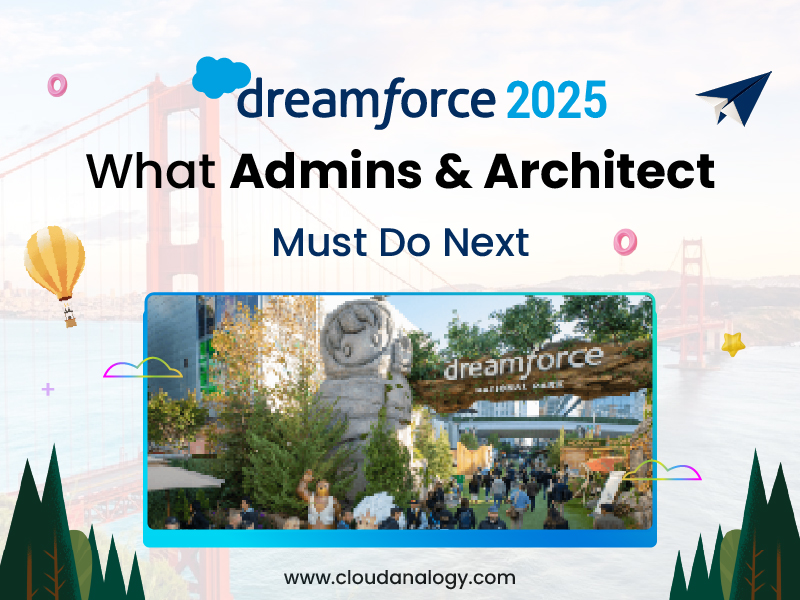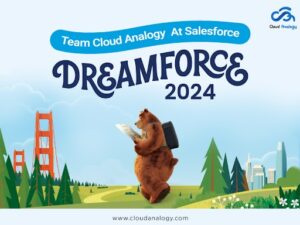Sharing is caring!
The updates and announcements from Dreamforce 2025 were nothing short of revolutionary. The event showcased groundbreaking innovations, with MCUtility, the multichannel messaging app from Cloud Analogy, taking center stage as the Demo Jam winner—a clear highlight of the biggest Salesforce conference.
Salesforce unveiled the concept of the “Agentic Enterprise,” where autonomous AI agents collaborate seamlessly with humans to boost productivity across every role and process. This paradigm shift redefines the responsibilities of admins and architects, moving them from managing static systems to designing, governing, and scaling intelligent, dynamic workflows in real time.
From AI-powered conversational tools to advanced agent platforms, Salesforce is enabling organizations to build smarter, more efficient processes. Here’s a deep dive into the key takeaways and what admins and architects must do next.
Admins: Powering the Agentic Enterprise
Admins play a central role in the new Agentic Enterprise. The skills you already have—like managing data, keeping systems secure, analyzing information, and helping users—are exactly what’s needed to make AI agents work effectively. You don’t need to start from scratch; your existing expertise makes you a key player in boosting productivity with AI.
Today, admins are more than system maintainers—they are builders of smart workflows that let humans and AI work together smoothly, helping teams get more done in less time.
Agentforce 360: The Platform That Connects Everything
The centerpiece of Dreamforce 2025 was Agentforce 360, Salesforce’s AI-first platform for creating agents that reason, act, and collaborate with humans. Its four core components include:
1. Agentforce Platform – With Agentforce Builder (a conversational development studio) and Agentforce Voice (real-time natural voice interactions).
2. Data 360 – The data backbone providing context through Intelligent Context and Tableau Semantics.
3. Customer 360 Apps – Housing business logic and process knowledge for agents to take real action.
4. Slack: The collaborative interface for humans and AI agents to interact seamlessly.
This integration allows admins to build grounded, reliable AI agents using existing Salesforce data and workflows—without starting from scratch.
Build AI Agents With Ease
The Agentforce Builder enables admins to design, test, and deploy agents in plain English. Key features include:
- Writing or adjusting agent logic using natural language.
- Simulating real-world interactions for instant testing.
- Switching between doc-style, low-code, and script views.
It’s a low-code meets AI experience designed to empower admins to create intelligent agents without needing extensive coding knowledge.
Agentforce Voice: Conversational AI at Its Best
Agentforce Voice transforms customer interactions. Instead of navigating outdated IVR menus, customers engage with a human-like AI that can access records, trigger automations, and update data—all in real time.
Enterprise-grade governance ensures every interaction is auditable through Data 360, combining AI efficiency with complete compliance and trust.
Set up Gets Conversational
Admins often spend too much time hunting for settings in Setup. Now, with Agentforce for Setup, you can ask questions in natural language and receive actionable results instantly. Assign permission sets, troubleshoot issues, or confirm configurations—all within a single conversational flow.
Smarter Security, Simplified
Security management has been elevated with AI-powered guidance. The Setup agent can troubleshoot permissions conversationally, while Security Center and Shield now leverage Agentforce to flag risky settings and compliance issues automatically. Think of it as having a security co-pilot safeguarding your org 24/7.
Slack as the Collaboration Hub
Slack is now more than a messaging platform—it’s where AI and humans work side by side. Agents like Agent Aloha can book rooms, generate contracts, and perform other tasks directly in Slack. Slackbot can surface Salesforce data, create canvases, and provide meeting briefs—all in real time—eliminating context switching.
Key Takeaways for Architects
Architects must now focus on reliable, fast, and user-friendly AI agent implementations. Highlights include:
1. Agent Script – A new scripting language that provides deterministic control over AI agents while maintaining flexibility.
2. Agentforce Vibes – Enables rapid prototyping and development of Lightning Web Components and reusable code, making business requirements executable at speed.
3. Scale Center & Apex Guru – Offer performance visibility and AI-powered code recommendations, now available across all Salesforce editions.
4. SLDS2 & Dark Mode – Modernized UI and accessibility improvements, with guidance for smooth transition.
Architects must prioritize governance, scalability, and predictability while ensuring AI agents remain auditable and compliant.
Actions for Admins
Admins can take practical steps to leverage these innovations:
1. Master conversational workflows – Experiment with Agentforce Builder and Setup powered by Agentforce.
2. Become Flow experts – Migrate old automations and build complex flows with native approvals.
3. Strengthen DevOps practices – Utilize DX Inspector for metadata tracking and for deployments of reference data.
4. Prioritize security – Use Agentforce insights to run risk assessments and maintain compliance.
5. Upskill in AI – Leverage Tableau Semantics and Einstein insights to transform from system troubleshooters into workflow architects.
Actions for Architects
Architects should focus on building future-ready AI systems:
1. Lead AI governance – Implement the Agentforce Development Lifecycle (ADLC) to manage agents reliably.
2. Predictable AI: Leverage Agent Script for deterministic logic and testing.
3. Master data architecture – Ensure Data 360 provides a clean, trusted context for agents.
4. Embrace multi-cloud – Integrate AI and data from multiple sources via the Model Context Protocol (MCP).
5. Refine soft skills – Clearly communicate architectural decisions to both technical and business stakeholders.
6. Stay current – Keep up with emerging technologies, security challenges, and Salesforce updates via Trailhead and the Architecture Center.
Conclusion
Dreamforce 2025 has positioned Salesforce Admins and Architects at the forefront of the Agentic Enterprise. The tools and features unveiled—Agentforce 360, Agentforce Voice, Agent Script, and Scale Center—empower Salesforce professionals to design intelligent, secure, and scalable solutions.
For admins, the focus is on mastering conversational workflows and AI-driven automation. For architects, the priority is governance, predictability, and interoperability. Together, these roles will define how humans and AI agents collaborate, unlocking unprecedented productivity across the enterprise.
This year’s Dreamforce was an incredible experience! The Cloud Analogy team witnessed firsthand the future of the Agentic Enterprise, AI-powered workflows, and next-level Salesforce innovations like Agentforce 360 and Slack integration.
From showcasing cutting-edge apps like MCUtility to exploring the latest Salesforce features, our experts were at the forefront of every breakthrough. Now, bring that expertise to your organization by partnering with the best Salesforce consulting team. Whether you need AI-driven workflows, advanced integrations, or seamless Salesforce implementation, Cloud Analogy delivers trusted, results-driven Salesforce consulting services to bring countless benefits to your business. Hire the best Salesforce consulting partner today and take your business operations to the next level with top-rated Salesforce AppExchange Apps.
Frequently Asked Questions (FAQs)
The Agentic Enterprise is Salesforce’s vision where autonomous AI agents collaborate with humans to boost productivity across every role, transforming workflows for admins and architects.
Admins can leverage Agentforce Builder and Agentforce Voice to design, test, and deploy AI-driven workflows, manage permissions, and automate tasks conversationally, thereby enhancing the efficiency of Salesforce application development.
Architects can use Agent Script, Agentforce Vibes, Scale Center, and Apex Guru to build scalable, reliable, and governed AI solutions, ensuring top performance in Salesforce application development.
Leading consulting firms integrate tools like Agentforce Builder, MCP, and Slack AI assistants to design intelligent workflows, optimize code, and enable seamless human-agent collaboration for enterprise clients.
Yes! With Slack as the central hub, AI assistants like Agent Aloha handle tasks like booking rooms, generating contracts, and managing workflows without switching apps, boosting overall team productivity.










